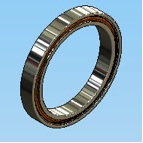We’re answering all of your questions about thin section bearings in this three-part series. Let’s get to it!

What are thin section bearings?
Thin Section Ball Bearings were developed to solve problems where standard deep groove ball bearings are not suitable. These are typically applications where there are space limitations, concerns with weight, and the loading and torque requirements require the use of a ball bearing. There are various definitions used in the industry and one of the more common ones is when the bore diameter is more than 4 times greater than the radial cross section, the bearing is considered a thin section. Cross sectional size can vary, but it is typically two times the ball diameter.
How many varieties of these ball bearing types are available?
Radial, angular contact, 4 point contact, full complement, duplex pairs and different cross sections. These are generally driven by the type and magnitude of loading.
How do you select the best thin section bearings for an application?
A typical bearing selection process can be used with thin section bearings. Normally, the space requirements will drive the designer to look at options within the family of thin section bearings. Next, the loading and operational conditions will dictate the type of thin section ball bearing that is most suitable, i.e. radial, angular contact, duplex pair, 4 point contact etc. After considering the maximum static and dynamic loads, the desired bearing life, and catalog data – for size, speed and load ratings, the final type, size, and bearing arrangement can be selected.
Additionally, other application inputs must be considered such as operating environment, rotational performance, mounting conditions, and temperature in order to determine the bearing specifications. These include precision level, clearance, lubricant, and type of closure (shields or seals).
Coming up in part 2, we look at operating conditions, and how they’ll dictate which thin section bearings should be used. In the meantime, if you have questions about thin section bearings – or any bearing products – our engineers and bearing experts are ready to help, contact them here.

